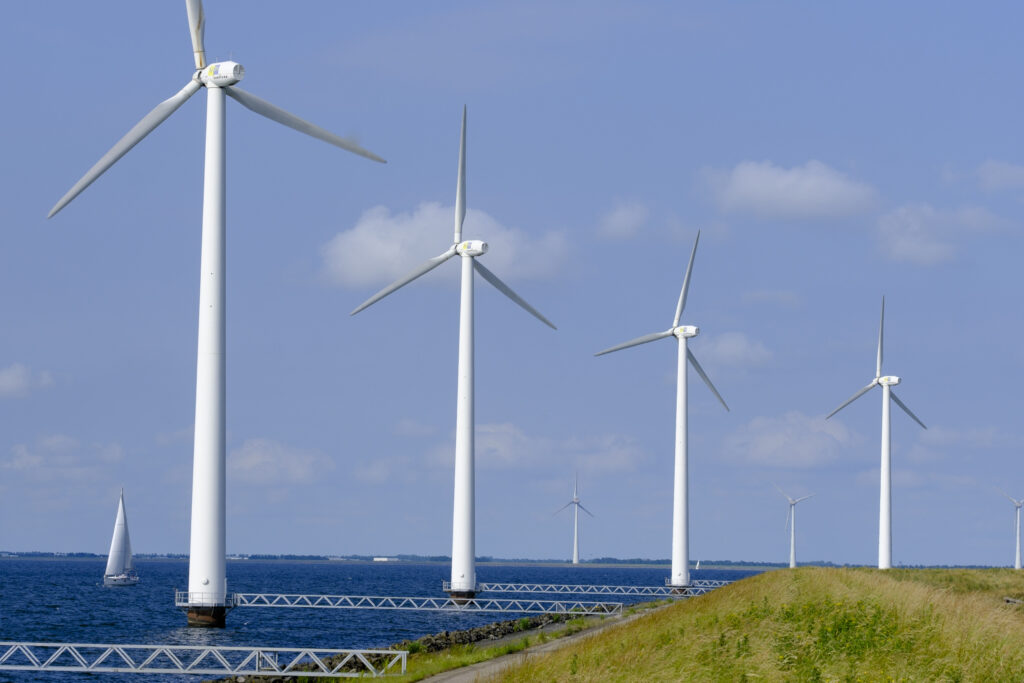The plan dramatically to cut the combustion of fossil fuels was accepted at the 2015 Paris
Conference. The instinctive reaction around the world has been to revert to the “Renewables”, the
sources of energy replenished intermittently by the power of the Sun. Unfortunately this power,
attenuated by the huge distance that it must travel to reach the Earth, is extremely weak. That is
why, before the advent of the Industrial Revolution, it was unable to provide the energy to sustain
even a small global population with an acceptable standard of living.
Today, modern technology is deployed to harvest these
weak sources of energy by building vast “farms” that
monopolise the natural environment to the detriment of
other creatures. Developments are made regardless of
the damage wrought. Hydro–electric schemes, enormous
turbines and square miles of solar panels are constructed,
despite being unreliable and ineffective, even
unnecessary [1].
In particular, the generation of electricity by wind is
disappointing. The evidence does not justify the environmental enthusiasm and the investor hype,
even for offshore wind that can be deployed well away from the infamous My Back Yard. What does
such evidence actually show?
That the wind fluctuates is common knowledge. But these fluctuations are grossly magnified to an
extent that is not immediately obvious – and has nothing to do with the technology of the wind
turbine. The energy of the wind is that of the moving air, and, as every student knows, such energy is
½Mv2, where M is the mass of air and v the speed. The mass of air reaching each square metre of
the turbine in a second is M=ρv, where ρ is the density of air, about 1.2 Kg per cubic metre. So, the
maximum power that the turbine can deliver is ½ρv3 watts per square metre.
If the wind speed is 10 metres per second (about 20 mph) the poweris 600 watts per square metre
[2]. That means to deliver the same power as Hinkley Point C (3,200 million watts) by wind would
require 5.5 million square metres of turbine swept area – that should be quite unacceptable to
environmentalists and anyone who cares about birds.
But look at that simple formula again. Because the power
carried by the wind depend on the third power of the
wind speed, when the wind drops to half speed, the
power available drops to an eighth. Almost worse, if the
wind speed doubles, the power delivered goes up 8 times,
and as a result the turbine has to be turned off for its own
protection. This is not related to the technology of the turbine which can only harvest the power
that reaches the area swept by its blades.
The effect of the enhanced fluctuations is dramatic. In the plot the blue area shows the total EU+UK
wind energy generated each day in 2021. The installed nominal generating capacity was 236 GW
(the brown dashed line), but the highest output in the year was 103 GW (26 March). This is not the
headline plot that the industry shows to its investors, the media and politicians, but it comes from
their own published annual WindEurope Report for 2021.
The wind blows somewhat more steadily offshore, as every sailor knows. Nevertheless, the
dangerous unreliability inherent in wind energy persists. The green trace on the graphic below
shows the offshore wind power generated by all UK farms in March 2022, as presented online on the
Crown Estate website. Over some periods it rose to the nominal installed capacity of 10 GW.
However, for 8 days at the end of the month it averaged no more than 1.2 GW. The red rectangle
(added) illustrates that 8.8 GW was not available for 8 days. That much energy, 1600 GWhrs, is 1000
times the capacity of the world’s largest grid storage battery (Moss Landings, California).
Battery technology has its own problems. It may provide for laptops and other portable applications,
even car batteries at up to 75 KWhrs (for 10–20 K$), but for much larger batteries there are problems
of cost, safety [3] and mineral shortages [4]. Batteries 20 million times larger are never going to be
available and storage batteries will never make good the failure of offshore wind farms, even for a
week. And the wind can drop for longer periods than that.
But the bluster of windfarm politics as pursued by the UK
Government ignores evidence, it seems. The industry is
keen to promote onshore wind also. However there the
fluctuations are greater than offshore and the political
deterrence from My Back Yard is stronger. Consequently,
the Government has promoted offshore projects. On 6
October 2020 Boris Johnson announced that “wind farms
could power every home by 2030”. He continued to
harangue the public in Churchillian tone “Your kettle, your washing machine, your cooker, your
heating, your plug–in electric vehicle – the whole lot of them will get their juice cleanly and without
guilt from the breezes that blow around these islands.” He was describing Government policy to
expand existing off–shore wind power from the existing capacity of 10.4GW by an additional 40 GW,
in addition to the already installed on–shore capacity of 13.6 GW. The significant word in the
announcement was “could”. Evidently offshore wind might provide such lighting in the UK –
sometimes. “Wind is cheap” it is often said, but if the required back–up supply (fossil fuel or nuclear)
is provided the contribution of wind becomes superfluous. Consumers need reliable energy all the
time. The possibility of free energy tomorrow is no help today. They should follow Alice who, in
negotiating terms with the White Queen, insisted on clarification of the day on which jam would be
delivered [5].
With general energy shortages, the war in Europe, high prices and the likelihood of failures in
electricity supply, many popular scientific presumptions underlying energy policy should be
questioned. Wind power fails that test.

